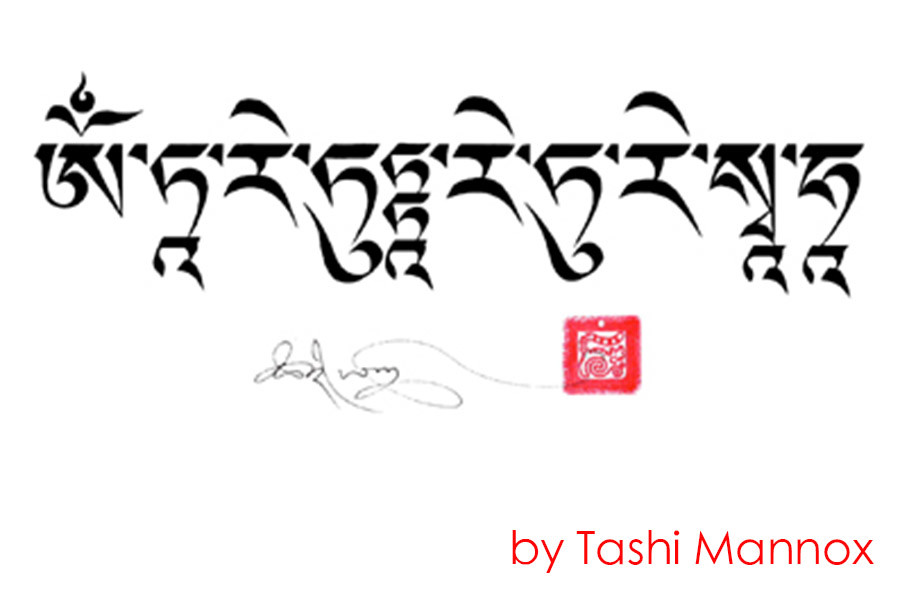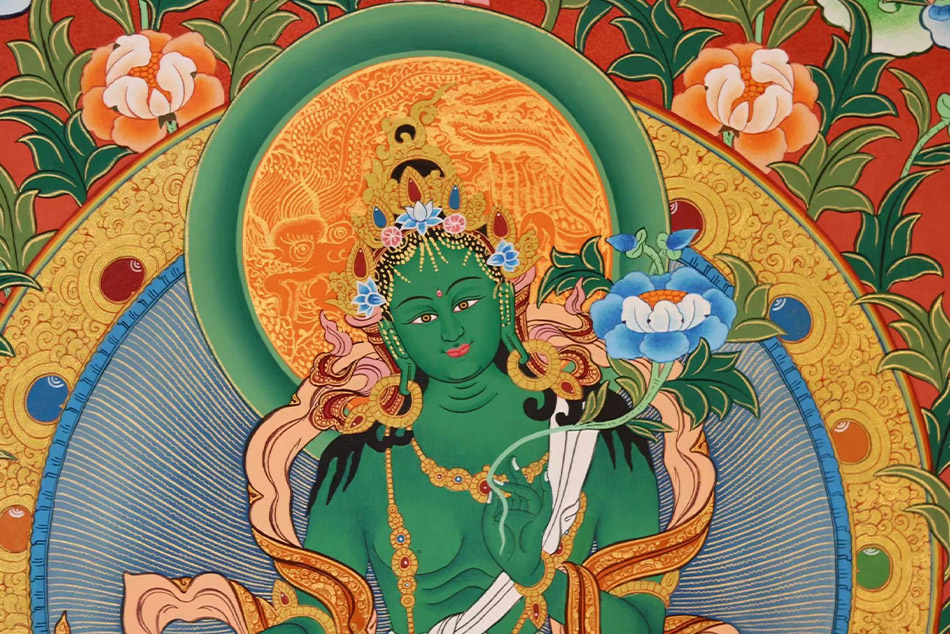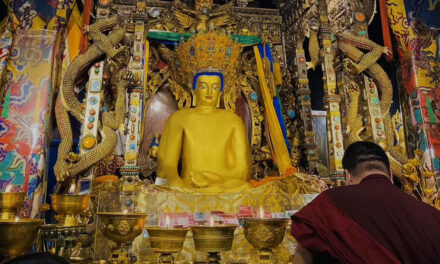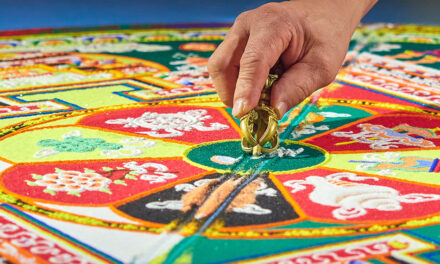In the mystical realm of Vajrayana Buddhism, Tara stands as a beacon of profound significance, transcending the boundaries of a mere deity. Often referred to as “Dorlma” in some traditions, Tara is an icon of boundless compassion, enlightenment, and profound wisdom. This article embarks on a transformative journey, inviting you to explore the multifaceted facets of Tara, unravel her intricate origins, fathom the depths of her significance, and understand the unwavering reverence she commands among her countless followers.
In a world where the spiritual and the material often clash, Tara serves as a profound bridge between the two, embodying the eternal truths that guide both our inner and outer worlds. She is more than a divine figure; she is the very embodiment of compassion, a torchbearer of enlightenment, and a wellspring of wisdom. Tara transcends the boundaries of gender, history, and culture, making her a universally revered symbol of the virtues that lead to spiritual awakening.
The mystique of Tara stretches beyond her origins; it delves into the profound narratives that shape her existence. From the tear of compassion shed by Avalokiteshvara to the noble vow of Yeshe Dawa, Tara’s story weaves a tapestry of resilience and devotion. It underscores the belief that compassion knows no gender, and that the pursuit of enlightenment is a path open to all who seek it.
As we venture deeper into this exploration, we’ll encounter Tara’s various forms, each an embodiment of a distinct facet of her compassionate nature. White Tara, the symbol of purity, is a testament to the cleansing power of Tara’s compassion, while Green Tara, the swift protector, reminds us of her readiness to aid those in need.
Tara’s presence is a guiding light on the path to spiritual awakening, providing protection, guidance, and blessings to those who seek her solace. Her mantra, “Om Tare Tuttare Ture Swaha,” resonates in the hearts of her devotees, a powerful invocation that connects them with the wellspring of compassion and wisdom that Tara represents.
Throughout this journey, we will delve into the very essence of Tara, unveiling the layers of her mystique and understanding why she is held in such high regard across the vast tapestry of Buddhist traditions. Tara is not merely an icon; she is an embodiment of the boundless compassion that has the power to transform lives and inspire spiritual journeys.
As we continue to explore Tara’s stories, forms, and mantras, we invite you to embark on a journey of your own—a journey of discovery, enlightenment, and compassion. Tara is more than a concept; she is a source of inspiration, a wellspring of hope, and a guiding star in the firmament of spiritual exploration. Join us as we venture into the enigmatic world of Tara, where compassion knows no bounds, and enlightenment is within reach for all who seek it.
Origins of Tara
Tara’s origins are an intricate tapestry woven with threads of mysticism and divine narratives, creating a story that transcends the boundaries of time and space. While the specifics of her emergence may vary across different Buddhist traditions, one common thread runs through them all—a thread of unwavering commitment to compassion.
The mystique of Tara’s origins lies in the belief that she emerged from a single tear, a tear shed by Avalokiteshvara, the Bodhisattva of compassion. This tear, like a dewdrop glistening in the morning sun, fell to the earthly realm, creating a sacred lake. Out of the waters of this lake, a lotus unfurled, revealing the radiant goddess, Tara. This symbolic birth underlines Tara’s deep connection to compassion, as she is believed to be an embodiment of Avalokiteshvara’s boundless love and empathy.
This narrative showcases the profound interconnectedness between the divine and the mortal, as if the very fabric of the universe responded to the call of compassion and gave birth to Tara. The tear itself becomes a symbol of the tears shed by all sentient beings in the face of suffering, and Tara’s emergence signifies the compassionate response to this universal sorrow.
However, Tara’s origins are not confined to a single narrative. Another enchanting story unfolds, painting Tara as the reincarnation of Yeshe Dawa, a young princess whose name, ‘Wise Moon,’ illuminates the wisdom she carried within. Yeshe Dawa received special instructions concerning bodhicitta, the enlightened mind, and quickly achieved remarkable results. This young princess’s transformation into Tara is a testament to the power of the female form in the pursuit of enlightenment. When advised to pray for a male rebirth to progress further in her practice, Yeshe Dawa’s response was profound: “Only weak-minded people see gender as a barrier to attaining enlightenment. However, there have been very few who wished to work for the welfare of sentient beings in a female form. Therefore, since I have developed bodhicitta as a woman, for all my lifetimes along the path I vow to be born as a woman.”
Her vow is an unshakable commitment to compassion, proving that enlightenment knows no gender or form. Following this vow, Yeshe Dawa entered a deep meditative state, remaining in that trance for ten million years. This extraordinary dedication earned her the prophetic recognition of Buddha Tonyo Drupa, who foresaw her eventual manifestation as the supreme goddess, Tara, in many different world systems, including our own.
The diversity of Tara’s origin stories underscores the rich tapestry of belief and spirituality within Buddhism. These narratives remind us that compassion is a universal language that transcends time and place. Tara’s existence, whether born from a tear or as a result of a noble vow, underscores the timeless truth that compassion, in all its forms, is a guiding force in the pursuit of enlightenment.
The Tear of Compassion
In the ethereal world of Buddhist mythology, the story of Tara’s origin unfolds with a profound and poignant beginning—a tear of compassion shed by Avalokiteshvara, the Bodhisattva of compassion. This single tear, an embodiment of deep empathy and love for all sentient beings, holds the key to Tara’s emergence as a symbol of boundless compassion.
Avalokiteshvara, whose name means “The One Who Hears the Cries of the World,” is revered as the embodiment of compassion in the Buddhist tradition. When this Bodhisattva gazed upon a world full of suffering beings, his heart welled with an overwhelming sense of empathy. It was in this moment of intense emotion that a single tear of compassion escaped his eye. This tear, pristine and filled with the essence of his boundless love, descended to the earthly realm.
As this tear touched the earth, it brought forth not only a sacred lake but also the potential for the miraculous. The tear’s transformation into a sacred body of water symbolizes the profound connection between the divine and the earthly. It signifies the fluidity of compassion, its ability to traverse realms, and its transformative power to heal and nurture.
From the depths of this sacred lake, a lotus bloomed. This lotus, a universal symbol of purity and enlightenment, slowly unfurled its petals, revealing the luminous goddess, Tara. In this moment, Tara emerged as the embodiment of Avalokiteshvara’s compassion, crystallized in human form.
The symbolism of Tara’s emergence from a tear is a profound reminder that compassion is the essence of all existence. It transcends individual boundaries, flowing like a river, giving life to the arid landscapes of suffering, and transforming them into fertile grounds for spiritual growth. In Tara’s story, we witness the power of empathy and the transformative potential of a single tear.
Tara’s emergence from this tear encapsulates the belief that compassion is not just an abstract concept but a living, breathing force that nurtures and sustains all life. She is the embodiment of this compassionate force, always ready to extend her hand to those in need, offering solace and guidance on the path to enlightenment.
Tara’s existence, rooted in a tear of compassion, serves as a timeless testament to the belief that, in the face of suffering, compassion is the bridge that connects the divine and the human, the celestial and the earthly, and ultimately, one sentient being to another.
Yeshe Dawa’s Transformation
The narrative surrounding Tara’s origins takes yet another enthralling turn as we delve into the story of her transformation from a young princess named Yeshe Dawa, also known as ‘Wise Moon.’ This tale resonates as a powerful reminder of the gender neutrality that exists in the pursuit of enlightenment. Yeshe Dawa’s unwavering commitment to remain in a female form throughout her lifetimes, solely for the welfare of sentient beings, stands as a testament to the remarkable spiritual strength of women.
Yeshe Dawa, whose name beautifully signifies ‘Wise Moon,’ exemplified the wisdom and enlightenment that could be achieved by individuals irrespective of their gender. Her journey into the realm of spirituality was marked by exceptional dedication and the pursuit of the highest ideals.
Yeshe Dawa received special instructions regarding bodhicitta, the awakened mind and heart that seeks the betterment of all beings. These teachings, handed down by a revered teacher, sparked a profound transformation within her. Her heart filled with compassion, and her spirit was ignited by the desire to alleviate the suffering of the world.
This young princess’s spiritual journey was nothing short of extraordinary. As she delved deeper into the teachings of bodhicitta, her progress was nothing short of remarkable. Her achievements captured the attention of her fellow practitioners, leading to a pivotal moment in her spiritual journey.
One day, a fellow monk, observing her exceptional progress, suggested that she should now pray for a male rebirth in order to advance further on the path to enlightenment. The prevailing belief was that, historically, male forms were more conducive to spiritual progress. Yet, Yeshe Dawa’s response was a resounding declaration of her unwavering commitment to compassion and to breaking the chains of gender bias on the path to enlightenment.
With unwavering resolve, Yeshe Dawa responded, “Only weak-minded people see gender as a barrier to attaining enlightenment. However, it is true that there have been very few who wished to work for the welfare of sentient beings in a female form. Therefore, since I have developed bodhicitta as a woman, for all my lifetimes along the path, I vow to be born as a woman.”
Her declaration resonates as a resounding tribute to the strength and determination of women in the realm of spiritual growth. Yeshe Dawa, through her vow, shattered the shackles of traditional expectations and paved the way for countless women to embrace the path of enlightenment without constraints.
Upon making this profound vow, Yeshe Dawa entered a deep state of meditation, one that would span ten million years. Her unwavering dedication to the cause of sentient beings, regardless of gender, earned her the prophetic recognition of Buddha Tonyo Drupa. He foretold her eventual manifestation as the supreme goddess, Tara, across various world systems, including our own.
Yeshe Dawa’s story, in its essence, transcends time and remains an enduring symbol of empowerment, resilience, and the universal accessibility of enlightenment. It underscores the limitless potential of individuals, regardless of their gender, to pursue the path of compassion, wisdom, and spiritual growth. Tara, in her manifestation as Yeshe Dawa, embodies the strength of women in spirituality and the boundless compassion that knows no gender boundaries.
The Prophecy of Tara’s Enlightenment
The captivating narrative of Tara’s origin takes a prophetic turn as we delve into the remarkable prophecy made by Buddha Tonyo Drupa, a visionary that saw the potential of Yeshe Dawa’s profound spiritual journey. As a result of her unwavering dedication and deep meditation, Buddha Tonyo Drupa foretold that she would attain supreme enlightenment and manifest herself as the Goddess Tara across various world systems, including our own.
The prophecy of Tara’s enlightenment is a testament to the transcendent power of devotion and compassion. Yeshe Dawa’s journey, marked by her vow to remain female throughout her lifetimes for the welfare of sentient beings, is one that reverberates across the cosmos. It is a story that spans not only time and space but also the boundless dimensions of the spiritual realm.
Yeshe Dawa’s meditation, which continued for an astounding ten million years, was a profound act of selflessness. It was a testament to her commitment to the betterment of all beings, regardless of their gender or form. Her unwavering dedication to the pursuit of enlightenment and compassion set the stage for the remarkable prophecy that would shape the course of her existence.
Buddha Tonyo Drupa, with his deep insight and understanding of the spiritual realm, recognized the extraordinary potential within Yeshe Dawa. He saw beyond the boundaries of time and place, foreseeing her eventual transformation into the Goddess Tara, a revered figure in various world systems.
This prophecy underscores the interconnectedness of all spiritual beings, transcending the limitations of the earthly realm. It serves as a reminder that the pursuit of enlightenment is a universal quest that knows no confines. Whether in our world or in distant realms, the principles of compassion and wisdom resonate universally.
Tara, in her essence as the manifestation of Yeshe Dawa, embodies the hope that enlightenment is a journey accessible to all. Her prophecy is a symbol of the profound interplay between the spiritual and the divine, reflecting the belief that compassion and devotion are forces that ripple through the cosmos, touching the lives of all sentient beings.
In the tapestry of Tara’s story, the prophecy of her enlightenment stands as a shimmering thread, illuminating the path to spiritual growth and the boundless potential that exists within the heart of every individual. Tara, whether in our world or in distant dimensions, is a beacon of hope, a symbol of the universal quest for enlightenment, and a testament to the transformative power of unwavering dedication and compassion.
Tara’s Many Forms
The mystical and multifaceted figure of Tara is not confined to a single manifestation. Within Vajrayana Buddhism, she assumes various forms, each with unique attributes and symbolism. In fact, there are 21 different forms of Tara, each holding a distinct purpose and significance. These 21 Taras collectively embody the multifaceted nature of compassion, and they offer solace and guidance to those who seek their blessings.
- Green Tara (Sgrol-ljang): As one of the most revered forms, Green Tara is known as the “Swift Liberator.” She is quick to come to the aid of those in need, offering protection and guidance on the path to enlightenment.
- White Tara (Sgrol-dkar): White Tara is a symbol of purity and compassion. She is often depicted holding a full-blown lotus and is associated with longevity, healing, and rejuvenation.
- Red Tara (Sgrol-ma Mar-po): Red Tara is associated with powerful love and fierce compassion. She is invoked for matters of the heart, bringing love, passion, and protection.
- Blue Tara (Sgrol-lham): Blue Tara is a protector from danger, particularly from anger, hatred, and violence. She is revered for her swift action in removing obstacles.
- Black Tara (Sgrol-ma Nag-mo): Black Tara is associated with power and force. She is often invoked to protect against negative energies and to provide strength in challenging situations.
- Yellow Tara (Sgrol-ma Ser-od): Yellow Tara is known for her power of wealth and prosperity. She brings abundance and financial well-being to her devotees.
- Golden Tara (Sgrol-ma Gser-lha): Golden Tara embodies enlightenment and spiritual wealth. She is invoked for wisdom and guidance on the path to awakening.
- Silver Tara (Sgrol-ma Nag-po): Silver Tara represents purity and clarity of thought. She is revered for her ability to dispel confusion and provide mental clarity.
- Cittamani Tara (Sgrol-ma Sems-dpa’ Ldan-ma): Cittamani Tara is often depicted as the wish-fulfilling jewel. She grants the wishes of her devotees and helps them achieve their goals.
- Parnashavari Tara (Sgrol-ma Ljang-sgom): Parnashavari Tara is associated with healing and protection from diseases and epidemics. She is a source of physical and emotional well-being.
- Nairatmya Tara (Sgrol-ma Bdag-med): Nairatmya Tara embodies the concept of selflessness and the non-dual nature of reality. She is revered for her role in understanding the ultimate truth.
- Vajra Tara (Sgrol-ma Rdo-rje-ljang-ma): Vajra Tara is associated with the indestructible nature of enlightenment. She symbolizes strength and resilience.
- Bhrikuti Tara (Sgrol-ma Yang-chen-mo): Bhrikuti Tara is often depicted with a third eye, symbolizing her ability to see the truth. She is invoked for clarity and insight.
- Ekajati Tara (Sgrol-ma Ral-chig-ma): Ekajati Tara is known for her ability to protect against negative energies and obstacles on the spiritual path.
- Ugra Tara (Sgrol-ma Drag-po): Ugra Tara embodies fierceness and fearlessness. She is a guardian against threats and negative influences.
- Mahacinatara (Sgrol-ma Zab-mo Ching): Mahacinatara represents the highest wisdom and awakening. She is invoked for profound insights and spiritual growth.
- Khadiravani Tara (Sgrol-ma Seng-ge-sge-pa): Khadiravani Tara is associated with forest and wilderness. She embodies the purity of nature and is invoked for protection in natural settings.
- Krishna Tara (Sgrol-ma Nag-po Lha-mo): Krishna Tara, also known as the “Dark Goddess,” represents the depths of wisdom and the mysteries of the universe.
- Trailokyavijaya Tara (Sgrol-ma ‘Jig-rten-las-‘phros-pa): Trailokyavijaya Tara is a protector against external threats and adversities. She grants victory over obstacles.
- Pretasana Tara (Sgrol-ma Yid-‘grog-ma): Pretasana Tara is revered for her power to liberate beings trapped in the state of the hungry ghost, offering them salvation.
- Ananda Tara (Sgrol-ma Bde-chen-lha-mo): Ananda Tara embodies great bliss and joy. She is invoked for emotional well-being and happiness.
Each of these 21 Taras brings her unique attributes and blessings to those who seek her guidance. Collectively, they represent the myriad ways in which compassion and enlightenment can manifest in our lives, offering solace and inspiration on the spiritual journey.
The Universal Compassion of Tara
Tara, in all her forms, is the living embodiment of universal compassion. She transcends the boundaries of culture, time, and belief systems, and she represents the essence of virtuous and enlightened actions. As the spiritual journey unfolds, Tara emerges as a guardian and a guiding light, offering protection, guidance, and an abundance of blessings to her countless followers.
Tara’s compassion knows no bounds. Whether as the swift Green Tara or the pure White Tara, her divine presence is a testament to the boundless well of empathy that resides within the universe. She is the essence of selfless love and the beacon of hope for all who traverse the intricate pathways of the spiritual realm.
In her role as a guardian, Tara watches over her devotees, providing solace and protection. She stands as a source of unwavering support for those who face the trials and tribulations of life. When called upon, she swiftly comes to their aid, much like a compassionate mother, shielding her children from harm.
Tara’s guidance is a profound gift to those who seek spiritual enlightenment. She whispers wisdom into the hearts of her followers, offering insights and clarity on the intricate and sometimes bewildering journey of awakening. Her wisdom, often delivered in gentle whispers or quiet moments of insight, serves as a timeless source of guidance for all who seek her.
Tara’s blessings flow like a river, nurturing the spiritual growth of her devotees. Her divine presence brings peace, prosperity, and enlightenment into the lives of those who invoke her. Whether it’s the purity of White Tara’s blessings or the fierce protection of Red Tara, her gifts are as varied and abundant as the universe itself.
Through all the forms Tara assumes, the common thread that binds them is the essence of compassion. She is a guardian, a guide, and a bestower of blessings. She offers her devotees not only a glimpse of enlightenment but also the strength and resolve to journey through life with courage and kindness.
As the spiritual voyage continues, one thing remains certain: Tara, with her universal compassion, will always stand as a constant and unwavering presence in the hearts of her followers. She is the source of hope, the font of wisdom, and the protector of souls, ever ready to extend her loving hand to those in need. Tara’s universal compassion is a timeless reminder that, in the intricate dance of the cosmos, compassion is the heartbeat that unites us all.
Unlocking Tara’s Mantra
In the realm of Vajrayana Buddhism, the mantra “Om Tare Tuttare Ture Swaha” is not just a collection of syllables; it is a powerful key that unlocks the floodgates of Tara’s divine compassion and guidance. The mantra serves as a direct channel to the heart of Tara, allowing her blessings and assistance to flow into the lives of those who recite it with devotion and sincerity.
“Om Tare Tuttare Ture Swaha” is a sacred invocation, a poetic sequence of sounds that transcends the boundaries of ordinary speech. It holds within its syllables the resonance of compassion, the essence of enlightenment, and the promise of spiritual protection. When recited, it acts as a beacon that calls upon Tara, drawing her near to those who seek her solace.
The mantra’s syllables carry profound meanings:
- Om: This sacred syllable represents the universal essence of reality. It is the sound of creation, the vibration of the cosmos. In the context of the mantra, it signifies the body, speech, and mind of Tara.
- Tare: This syllable invokes Tara as the liberator. It represents her role in releasing beings from suffering, much like a mother rescuing her children from harm.
- Tuttare: Tuttare symbolizes Tara as the protector. It calls upon her to shield her devotees from fear, danger, and external threats, much like a guardian would protect those under their care.
- Ture: Ture represents Tara’s ability to eliminate internal obstacles and negative emotions. It is an appeal to her to dispel doubts, anger, and confusion from the minds of her devotees.
- Swaha: Swaha is a concluding syllable often used in mantras, signifying the offering of one’s ego and selfish desires to the divine. It represents surrender and devotion, an act of giving oneself wholly to Tara’s guidance.
Reciting this mantra is not a mere mechanical exercise; it is an act of devotion and a deep connection with Tara’s compassion. Each utterance of the mantra is an offering, a heartfelt plea for her assistance and blessings. It is a journey from the ordinary world into the spiritual realm, where Tara’s presence becomes palpable.
The mantra is a bridge between the material and the spiritual, a vehicle for transmitting one’s desires, fears, and hopes to the divine. It is an act of faith, a declaration of one’s trust in Tara’s boundless compassion and guidance. Through the mantra, Tara’s devotees find not only solace and protection but also a profound sense of connection with the divine.
As you recite “Om Tare Tuttare Ture Swaha,” the words become a conduit for your intentions and emotions. Tara, in all her forms, listens to your voice, resonates with your heart, and responds with the compassion that knows no bounds. This sacred mantra is more than a collection of sounds; it is a transformative key that opens the door to the divine and unlocks the blessings of Tara’s universal compassion.

Conclusion:
In the vibrant tapestry of Vajrayana Buddhism, Tara, known as Dorlma in some traditions, stands as a luminous figure of immense significance. Her stories and myriad forms serve as profound testaments to the inclusivity and boundless compassion that are at the core of Buddhist beliefs. Whether as the embodiment of purity, the swift protector, or the fierce guardian, Tara’s unwavering compassion knows no bounds, transcending time and space.
Tara’s enduring presence in the spiritual landscape serves as a reminder that compassion is not merely an abstract concept; it is a living, breathing force that pulses through the universe. She is not confined to a specific time, place, or culture; she transcends these limitations, becoming a symbol of empathy and enlightenment that resonates with countless souls across the world.
As we journey through the many facets of Tara, we discover a goddess whose origins are steeped in mysticism, whose emergence is marked by a tear of compassion, and whose promise is to remain a beacon of hope for the welfare of all sentient beings. Her transformation from Yeshe Dawa, the Wise Moon, underlines the spiritual strength of women and the inclusivity of enlightenment. She is a living testament to the belief that compassion knows no gender, and that the pursuit of enlightenment is a path open to all.
The prophetic vision of Tara’s eventual enlightenment, as foreseen by Buddha Tonyo Drupa, expands our understanding of her presence beyond our earthly realm. Tara, as the goddess of compassion, transcends the confines of our world, manifesting herself as a beacon of hope and enlightenment in countless other world systems. Her story reveals the interconnectedness of all spiritual beings and the universality of the quest for awakening.
Tara’s diverse forms, including the 21 Taras, illustrate the manifold facets of compassion and enlightenment. Each form serves a unique purpose and offers specific blessings, embodying the varied needs and aspirations of her devotees. Tara’s presence is a testament to the malleability and resilience of compassion, which flows and adapts to the diverse experiences of humanity.
As we conclude this exploration of Tara, we are reminded that she is more than a deity; she is a symbol of unwavering compassion and wisdom, an eternal beacon of hope and enlightenment. Her universal appeal transcends the confines of tradition, culture, and belief, resonating with all who seek the solace and guidance that her compassion offers.
Tara is a timeless reminder that in the ever-shifting sands of existence, compassion remains a constant, an eternal flame that lights our path on the journey to enlightenment. She embodies the universal language of the heart, speaking to all who seek solace, guidance, and blessings on the profound spiritual voyage. Tara, the embodiment of boundless compassion, will forever stand as an enduring source of inspiration, a guardian of the soul, and an eternal beacon of hope.
FAQs
Can anyone recite Tara’s mantra, or is it reserved for Buddhists only?
The beauty of Tara’s mantra lies in its universal accessibility. It can be recited by anyone seeking Tara’s compassion and guidance, regardless of their religious beliefs. The mantra transcends the boundaries of faith, culture, and tradition. It is an open invitation to all, extending Tara’s blessings and solace to anyone who calls upon her with sincerity and devotion.
Tara’s compassion knows no limitations, and her mantra is a bridge that connects all hearts, offering a profound sense of connection with the divine. Whether you are a Buddhist or not, the mantra is a powerful tool that can unlock the floodgates of Tara’s boundless empathy, enveloping you in her loving embrace.
Are there specific rituals associated with invoking Tara’s blessings?
While there are traditional rituals associated with invoking Tara’s blessings, the essence of Tara’s compassion lies in the sincerity of one’s heart. The recitation of Tara’s mantra with a pure and devoted heart is often enough to seek her blessings.
However, for those who wish to engage in more elaborate rituals, there are various practices in Vajrayana Buddhism that involve offering prayers, lighting incense, and making offerings to Tara’s image or representation. These rituals can be deeply meaningful and provide a profound sense of connection to Tara. But it’s essential to remember that the core of these rituals is the devotion and intention behind them.
Whether through simple mantra recitation or more elaborate rituals, the key is the authenticity of one’s connection with Tara. She responds to the earnest and heartfelt call of her devotees, embracing them with her boundless compassion and guidance. Tara’s blessings are not bound by the intricacies of rituals; they flow freely to all who seek her with sincerity and devotion.
Are there specific days or occasions when it is most auspicious to pray to Tara?
Tara, in her compassionate nature, is known to be accessible at all times. Her divine presence transcends the limitations of specific days or occasions. As a symbol of boundless compassion and guidance, she is ever ready to respond to the heartfelt call of her devotees.
That said, some Buddhist festivals and special occasions may be considered particularly auspicious for seeking Tara’s blessings. During these times, devotees often engage in dedicated prayers and rituals to deepen their connection with Tara:
- Saka Dawa: This is an important Tibetan Buddhist festival that celebrates the birth, enlightenment, and passing into parinirvana of Gautama Buddha. Many Buddhists engage in virtuous actions and prayers during this month, and seeking Tara’s blessings is a common practice.
- Saga Dawa Düchen: This festival marks the day when Buddha Shakyamuni attained enlightenment. It is considered one of the holiest days in the Buddhist calendar, and reciting Tara’s mantra or engaging in prayers to her can be particularly auspicious.
- Tara Puja Days: Some Buddhist communities have specific days dedicated to Tara where devotees come together to recite her mantra and engage in practices that deepen their connection with her.
- Personal Occasions: While there are no restrictions on when you can seek Tara’s blessings, many individuals turn to Tara during significant life events, such as births, marriages, illness, or times of personal struggle. Tara’s unwavering compassion and guidance are often sought during these moments.
Ultimately, the choice of when to seek Tara’s blessings is a personal one, guided by individual needs and intentions. Tara’s compassion transcends the constraints of time, and she is always ready to embrace her devotees with open arms, offering solace, guidance, and blessings whenever they are sought.
What are the key differences between White Tara and Green Tara?
White Tara and Green Tara, while both revered forms of the goddess Tara, hold distinct attributes and symbolism within Vajrayana Buddhism. Understanding the key differences between these two manifestations provides insights into their roles and the blessings they bestow:
White Tara (Sgrol-dkar):
- Purity and Healing: White Tara is often associated with purity, representing the essence of unblemished compassion. Her primary focus lies in healing and rejuvenation.
- Longevity: She is revered for her ability to bestow longevity and a life free from suffering. Her blessings often include physical and emotional well-being.
- Symbol of Enlightenment: White Tara represents the embodiment of enlightened wisdom, offering guidance on the spiritual path and clarity of thought.
- Depiction: White Tara is typically depicted holding a full-blown lotus, a symbol of purity, and she is often seen with a third eye, signifying her ability to perceive the truth.
Green Tara (Sgrol-ljang):
- Swift Action and Protection: Green Tara is known as the “Swift Liberator.” She is revered for her quick response to those in need and her powerful protection. Her compassion is fierce and immediate.
- Guidance and Support: She offers guidance and support on the path to enlightenment. Devotees turn to Green Tara for assistance in overcoming obstacles, fears, and challenges.
- Symbol of Activity: Green Tara’s color symbolizes activity and dynamism. She is depicted with one leg extended, ready to spring into action.
- Seven Eyes: In some representations, Green Tara is shown with eyes on the soles of her feet and the palms of her hands, making her the “Tara of the Seven Eyes.” This signifies her ability to watch over and protect her devotees from all directions.
While White Tara and Green Tara share a common essence of compassion, their distinct qualities make them suitable for different situations. White Tara offers the healing touch of purity and longevity, while Green Tara’s swift action and protective nature make her the go-to deity when facing immediate challenges and seeking guidance on the path to enlightenment.
How can I deepen my connection with Tara in my spiritual practice?
Deepening your connection with Tara is a profoundly enriching journey that can be nurtured through various spiritual practices. Here are some ways to foster a closer bond with Tara:
Regular Meditation: Incorporate meditation into your spiritual routine, focusing on Tara as the object of your meditation. By centering your thoughts on her, you can cultivate a deeper sense of presence and connection.
Mantra Recitation: Regularly recite Tara’s mantra, “Om Tare Tuttare Ture Swaha.” The repetition of this sacred mantra not only serves as a channel to her compassion but also strengthens your spiritual connection with her.
Study Her Stories: Delve into the stories and legends surrounding Tara, such as her origins, forms, and manifestations. Understanding her significance within Buddhist beliefs will provide you with a deeper appreciation of her role and presence.
Personal Reflection: Take time for personal reflection and journaling. Write about your experiences and feelings in connection with Tara. This practice allows you to explore your spiritual journey and strengthen your bond with her.
Participate in Group Worship: If possible, join a community or temple where Tara is venerated. Participating in group worship and rituals can deepen your connection and provide a sense of shared spiritual community.
Acts of Compassion: Emulate Tara’s compassionate nature in your daily life. Engage in acts of kindness, generosity, and compassion toward others. By living in alignment with Tara’s principles, you strengthen your connection with her.
Offerings: Make offerings to Tara as a gesture of devotion. These offerings can be symbolic and need not be extravagant. What matters is the intention behind them.
Seek Guidance: If you have a spiritual teacher or guru, seek their guidance on how to deepen your connection with Tara. They can provide personalized advice and practices tailored to your spiritual journey.
Remember that deepening your connection with Tara is a personal and transformative process. It’s about nurturing your own spiritual growth and developing a profound relationship with her that resonates with your heart and soul. Through consistent practice, devotion, and reflection, you can strengthen your connection with Tara and experience the boundless compassion and guidance she offers.














